SKT
SK Telecom and Singtel partner to develop next-generation telco technologies using AI
SK Telecom (South Korea) and Singtel (Singapore) have initiated a two-year project to develop advanced telecommunication networks. This collaboration aims to drive innovation, improve network performance and security, and enhance customer experiences through the use of artificial intelligence (AI), orchestration tools, and network virtualization.
The project will focus on creating innovative solutions like Edge-AI Infrastructure to enhance connectivity and provide unique AI service offerings. A white paper will describe advancements to assist other global telcos to harnessing the capabilities of 5G and preparing for 6G.
This MOU initiative is expected to not only enhance connectivity but also provide customers with unique AI service offerings and enable the operators to restore services faster, thus improving the customer experience.
Additionally, SKT and Singtel will be putting together a white paper on their advancements in areas such as virtualization, slicing and network evolution that can help other telcos globally to capitalize on the capabilities of 5G and to prepare for 6G in 2030.

SK Telecom (SKT) has signed a Memorandum of Understanding (MOU) with Singtel, Singapore’s leading telecommunications provider, to collaborate on the application of AI technology in communication networks, the development of use cases for 5G network slicing technology, and preparation for 6G technology, aimed at fostering advancements in 5G and next-generation communication technologies. Photo Courtesy of SKT
……………………………………………………………………………………………………………………
Kang Jong-ryeol, SKT’s Head of ICT Infra(CSPO) stated, “The collaboration between SKT and Singtel marks a significant first step in shaping the future of the global telecommunications industry.” He further emphasized, “By combining the strengths of both companies, we aim to achieve efficient high-performance network construction, enhance network stability, and discover new network-based services. Additionally, we will strive to make significant advancements in next-generation communication technologies, including AI-powered wired and wireless infrastructure.”
Tay Yeow Lian, Singtel’s Managing Director, Networks, said, “As a global leader in 5G technology, we’re keen to capitalize on the myriad of capabilities this technology has to offer, especially in the areas of network slicing and with the inclusion of AI. With SKT, we’re looking to not only enhance the experience of our customers but to also drive industry innovation and help us prepare for the evolution to 6G.”
ANNEX: Singtel’s 5G advancements
· Developed Paragon, the industry’s first all-in-one aggregation and business orchestration platform, which allows enterprises to interact with and manage networks, clouds and multi-access edge computing (MEC) infrastructure and applications
· Developed Singtel CUBΣ, a Network-as-a-Service (NaaS) that makes it easier for enterprises to subscribe and manage desired services and multiple vendors as well as gain insights on network utilisation, workload performance and sustainability metrics via a single sign-on digital portal. CUBΣ leverages and integrates AI into its network management systems to deliver enhanced services such as proactive user experience monitoring, incident automation and predictive analytics to anticipate, detect and address incidents faster. This results in improved network performance, optimised resource allocation, enhanced security protocols, elevated the overall user experience, and the development of a network that learns, evolves and self-improves over time – all of which enable faster digital transformation for greater economic growth and innovation.
Major 5G developments from Singtel:
2022
· Launched first public multi-access edge compute for enterprises in Asia with Microsoft
· Launched iSHIP to provide critical satellite-enabled connectivity and digital services for the maritime industry
2023
· Singapore’s first 5G-enabled smart retail showcase
· Achieved 5G upload speed of more than 1.6Gbps in an enterprise deployment
· Completed more than 30 5G trials at Sentosa
· Successfully trialed RedCap technology for better energy savings for IoT devices
2024
· Addition of Starlink satellites for maritime connectivity
· Offered the 5G Express Pass service to concertgoers for Coldplay and Taylor Swift
· Pioneered app-based network slicing, aka User Equipment Route Selection Policy
· Singtel Paragon integrated into Telkomsel’s enterprise product portfolio
· Launch of Paragon-S to spur digital transformation for satellite operators
About SK Telecom:
SK Telecom has been leading the growth of the mobile industry since 1984. Now, it is taking customer experience to new heights by extending beyond connectivity. By placing AI at the core of its business, SK Telecom is rapidly transforming into an AI company with a strong global presence. It is focusing on driving innovations in areas of AI Infrastructure, AI Transformation (AIX) and AI Service to deliver greater value for industry, society, and life.
References:
https://www.koreaittimes.com/news/articleView.html?idxno=132974
SK Telecom, DOCOMO, NTT and Nokia develop 6G AI-native air interface
SK Telecom, Intel develop low-latency technology for 6G core network
SK Telecom and Thales Trial Post-quantum Cryptography to Enhance Users’ Protection on 5G SA Network
SK Telecom, DOCOMO, NTT and Nokia develop 6G AI-native air interface
SK Telecom, DOCOMO, NTT and Nokia today announced they have partnered to develop the 6G AI-native air interface (AI-AI), a critical next-generation technology that could greatly boost network performance while increasing energy efficiency. The four companies will show video demonstration of an AI-AI proof of concept at SKT’s booth at Mobile World Congress in Barcelona, Feb. 26-29.
This new 6G collaboration builds on an existing relationship between DOCOMO, NTT and Nokia targeted at 6G innovation. With the addition of SKT, the four companies will be able to expand the scope and scale of 6G AI-AI testing and validation as well as explore a broader range of business use cases for the technology.
The collaboration is developing future proof-of-concept 6G AI-AI systems, which will then be put to the test using selected use cases and real environmental scenarios. These over-the-air validation tests will be conducted both in the lab and outdoors to best simulate real network results. SKT, NTT, DOCOMO and Nokia will cooperate on improving AI model performance by utilizing data generated from real networks or through simulation. This will be instrumental in developing AI training models for a best-in-industry AI-AI solution.
By working together, SKT, DOCOMO, NTT and Nokia will be able to combine their research efforts and bring their core areas of expertise to the table. SKT, DOCOMO and NTT are recognized worldwide for their successful adoption of every generation of networking and their ability to create new business value from advanced technologies, while Nokia’s industrial research arm, Nokia Bell Labs, is a leader in 6G innovation.
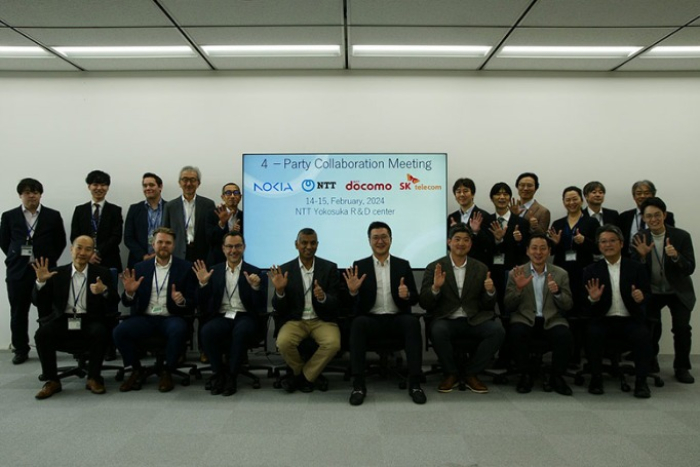
Photo Courtesy of SK Telecom
Yu Takki, Vice President and Head of Infra Tech at SKT, said: “ This milestone represents a significant step forward in collaborative efforts towards the development of 6G core technology involving technology leaders from Korea, Japan, Europe and the United States. SKT will maintain its momentum in its R&D efforts of applying AI technology to network infrastructure as we move forward to become a global AI company.”
Takaaki Sato, Executive Vice President and Chief Technology Officer at DOCOMO said: “DOCOMO and NTT are delighted to advance this project with Nokia, a global vendor leading the world, and SKT, a mobile operator co-leading Asia. Through this collaboration, we will take the lead in innovative technology development and standardization of 6G, and focus on building a global ecosystem that includes future industries and technologies.”
Peter Vetter, President of Bell Labs Core Research at Nokia, said: “For Nokia to create a world-class 6G system, it’s critical we get input from the service providers that will one day deploy 6G. SKT, NTT and DOCOMO are among the most innovative service providers in the world, which gives us the perfect partners to design the networks of the future.”
Editor’s Note: This 6G AI initiative has NOT yet been submitted to ITU-R WP 5D for inclusion in any IMT 2030 related draft document.
…………………………………………………………………………………………………
About SK Telecom:
SK Telecom has been leading the growth of the mobile industry since 1984. Now, it is taking customer experience to new heights by extending beyond connectivity. By placing AI at the core of its business, SK Telecom is rapidly transforming into an AI company with a strong global presence. It is focusing on driving innovations in areas of AI Infrastructure, AI Transformation (AIX) and AI Service to deliver greater value for industry, society, and life.
References:
https://www.sktelecom.com/en/press/press_detail.do?idx=1602¤tPage=1&type=&keyword=
https://www.kedglobal.com/tech,-media-telecom/newsView/ked202402220013
https://www.sktelecom.com/en/press/press_detail.do?idx=1601¤tPage=1&type=&keyword=
SK Telecom, Intel develop low-latency technology for 6G core network
SK Telecom and Deutsche Telekom to Jointly Develop Telco-specific Large Language Models (LLMs)
SK Telecom, Intel develop low-latency technology for 6G core network
In collaboration with Intel, SK Telecom (SKT) has successfully developed technology to reduce communication delays necessary for the evolution of 6G Core Network Architecture. The Core network is the gateway through which all voice and data traffic generated from a customer’s mobile device passes through to access the Internet network. It is a mobile communication service system that is responsible for security and service quality through the inter-connection of various systems.
Editor’s NOTE: Of course, 6G is currently undefined with only the features and functions being defined by ITU-R WP 5D which is meeting this week in Geneva. The 6G core network specifications will be done by 3GPP and NOT ITU-T as was the case for 5G core.
…………………………………………………………………………………………………………..
The 6G Core Architecture is required to have higher flexibility and safety than previous generations of wireless communications, and to provide stable AI service quality and technologies to customers by embedding intelligent and automation technologies.
As Core network technology continues to develop, the various systems that make up the network and the detailed functions that provide various services are also explosively increasing. As network complexity continues to increase, the process of sending and receiving messages is frequently recreated. Therefore, communication delays will increase compared to before. It is difficult to address these limitations with communication standard technologies (service communication proxies) for interconnection between unit functions within the existing Core network.
Inline Service Mesh, a low latency technology the two companies developed utilizing Intel Xeon processors with built in AI, is capable of increasing the communication speed within the Core network by reducing latency between unit function without Proxy.
Through this technology development, AI, which requires a large amount of computation, can be applied to the Core network in a wider variety of models. SKT has already commercialized a technology that reduces wireless resources by 40% and improves connectivity by analyzing movement patterns of real users in real time. Through this cooperation, the two companies will be able to reduce communication delays by 70% and increase service efficiency by 33% in the Core network through the application of the 6G Core Architecture.
SKT aims to apply the results of this study to commercial equipment next year. A technical white paper has been published by Intel that describes the technology, development process and benefits.
SKT and Intel have been continuing to cooperate for research on the development of key wired/wireless mobile communication technologies for the past 10 years. Based on the results of this study, the two companies plan to continue research and development for traffic processing improvement technologies incorporating AI technology in various areas of the Core network.
“We have made another technical achievement through continuous technology development cooperation with Intel to secure leadership in 6G,” said Yu Takki, Vice President and Head of Infra Tech at SKT. “We will continue our research and make efforts to commercialize AI-based 6G Core Architecture.”
“Our research and development efforts with SK Telecom continue to deliver innovations that have been deployed by Communications Service Providers worldwide”, said Dan Rodriguez, Corporate Vice President of Intel Network & Edge Solutions Group. “By leveraging the latest Intel Xeon processors with built in AI features, our companies are able to drive both performance and efficiency improvements that will be vital to the future Core networks.
Last March, SKT and NTT DOCOMO released a white paper addressing the requirements for future 6G networks.
The South Korean carrier said the new white paper contains its views on 6G key requirements and 6G evolution methodology, along with its opinions on the latest trends in frequency standardization. The 6G white paper also provides analysis, development directions and methodologies pertaining to promising 6G use cases, technology trends as well as and candidate frequencies.
The 6G White Paper reviews the following:
- Performance requirements and implementation scenarios for each frequency band, taking into account the characteristics of each frequency
- Issues concerning coverage and devices in high-frequency bands
- Standardization for migration to 6G architecture and application of cloud-native / open architecture
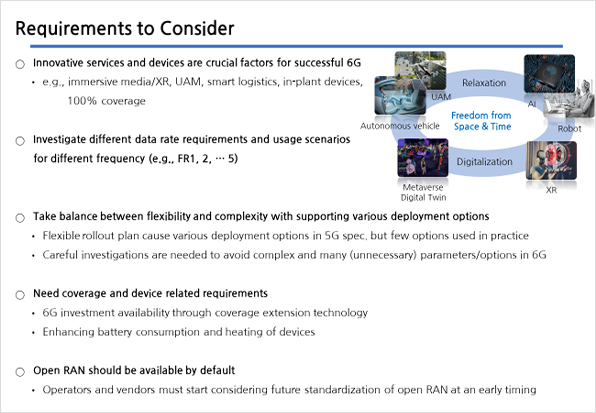
References:
https://www.sktelecom.com/en/press/press_detail.do?idx=1597¤tPage=1&type=&keyword=
NTT DOCOMO & SK Telecom Release White Papers on Energy Efficient 5G Mobile Networks and 6G Requirements
https://www.docomo.ne.jp/english/corporate/technology/rd/docomo6g/whitepaper_dcmskt.html#title02
SKT Develops Technology for Integration of Heterogeneous Quantum Cryptography Communication Networks
SK Telecom (SKT) today announced that for the first time in the world, it developed a technology that allows for integrated control and operation of quantum cryptography networks by integrating networks composed of equipment from different manufacturers via software-defined networking (SDN) and distributing quantum keys in an automated manner.
So far it was impossible to connect and operate quantum cryptography communication networks of different companies and countries. However, with SKT‘s new technology, quantum cryptography communication networks of diverse manufacturers, mobile operators and nations can be interconnected and co-operated.
The company said that it completed verification of the technology on the Korea Advanced Research Network (KOREN), a non-profit testbed network infrastructure operated by the National Information Society Agency (NIA) to facilitate research, test and verification of future network leading technologies and related equipment.
Based on the results of development and verification of the technology, SKT has been actively promoting standardization by sharing the case with global telcos.
To set international standards for the integration of quantum cryptography communication networks, SKT proposed two standardization tasks – i.e. ‘Control Interface of Software Defined Networks’ and ‘Orchestration Interface of Software Defined Networks for Interoperable Key Management System’ – to the European Telecommunications Standards Institute (ETSI), and they were chosen as work items by the ETSI industry specification group for QKD (ISG-QKD) in March 2023.
If approved as international standards, they will provide a technical basis for creating a large-scale network by interconnecting quantum cryptography communication networks built by many different operators. SKT plans to continue developing additional technologies for interworking of services between different operators/countries, as well as management of service quality.
Through these efforts, the company expects to strengthen the competitiveness of domestic companies and boost the quantum cryptography ecosystem both home and abroad.
Meanwhile, at this year’s IOWN Global Forum Workshop, SKT presented ‘Quantum Secure Interconnection for Critical Infrastructure,’ covering use cases for next-generation transmission encryption technology and proposal for a proof-of-concept (PoC) of quantum cryptography in All-Photonics Network (APN). The company also showcased its quantum cryptography communication technologies at 2023 MWC Barcelona.
“The two standardization tasks approved as work items by ETSI will boost the expansion of quantum cryptography communication in the global market,” said Ha Min-yong, Chief Development Officer of SKT. “We will work with diverse global players in many different areas to create new business opportunities in the global market.”
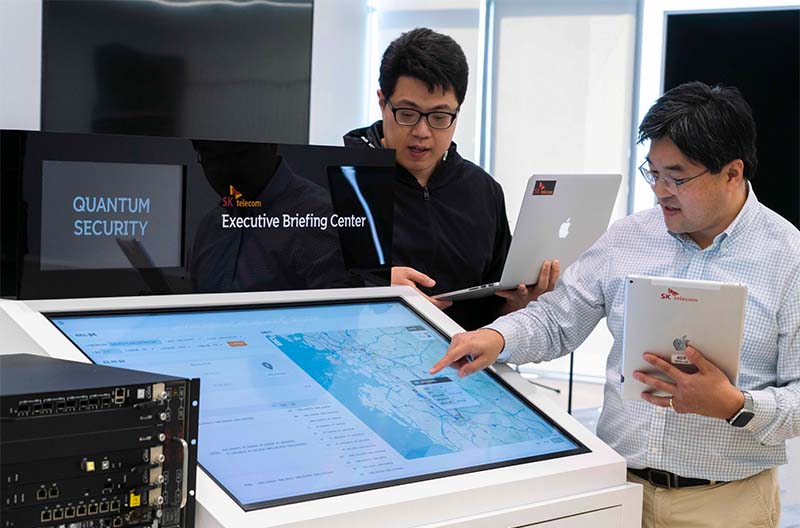
Disclaimer:
SK Telecom Co. Ltd. published this content on 05 April 2023 and is solely responsible for the information contained therein. https://www.sktelecom.com/en/press/press_detail.do?idx=1563¤tPage=1&type=&keyword=
………………………………………………………………………………………………………………………………………………………………….
From SDxCentral:
Quantum cryptography communication transmits each bit of information as a single photon of light, which encrypts that information against eavesdropping or decryption. Telecom operators and vendors have been working for several years on integrating that level of encryption into networks.
For instance, Toshiba and the Tohoku Medical Megabank Organization at Tohoku University used quantum technology in 2018 to hit one-month-average key distribution speeds exceeding 10 Mb/s over installed optical fiber lines. They also used the technology to monitor the performance of installed optical fiber lines in different environments.
Toshiba later partnered with U.K.-based operator BT on using QKD across to secure a network transmission.
SK Telecom also has a long quantum history, including work with Swiss-based strategic partner ID Quantique, which focuses on quantum cryptography communication technology.
Industry trade group GSMA last year announced its Post-Quantum Telco Network Taskforce focused on supporting the industry’s creation of a roadmap to secure networks, devices and systems across the entire supply chain.” That work was initiated with IBM and Vodafone, and has since gained more than 45 members.
Lory Thorpe, GSMA Post-Quantum Telco Networks chairperson and head of IBM Consulting’s Telco Transformation Offerings, told SDxCentral last month that the core objective of the taskforce is to ensure the implementation of the right requirements and standards in a timely manner to avoid being “late to the party.” Thorpe explained the initial problem statement was “around how do we support the telco ecosystem to navigate the path to quantum safe.”
“When you look at where cryptography is used in telco systems, it impacts basically all of the different systems. But it also then impacts all of the standards that underpin these systems as well,” she said. “We’re advocating that people start planning, not panicking, but at least planning because … this isn’t something that just happens overnight.”
NTT DOCOMO & SK Telecom Release White Papers on Energy Efficient 5G Mobile Networks and 6G Requirements
- Possibilities to achieve greater energy savings based on energy consumption levels measured in the two companies’ respective base stations
- Technical analysis of candidate energy-saving technologies, including both hardware and software
- The roles that operators and equipment vendors should play, including the need for greater coordination, in the effort to achieve greater energy savings
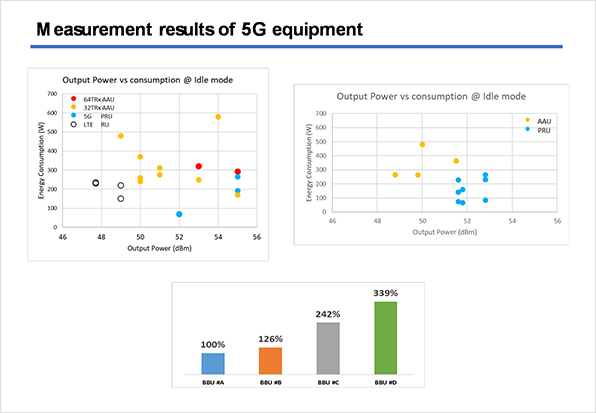
For 6G, the paper reviews requirements and challenges including specific performance levels and implementation scenarios, focusing on technical issues of particular importance to mobile operators:
- Performance requirements and implementation scenarios for each frequency band, taking into account the characteristics of each frequency
- Issues concerning coverage and devices in high-frequency bands
- Standardization for migration to 6G architecture and application of cloud-native / open architecture

Going forward, NTT DOCOMO and SKT will continue to collaborate in various technical fields, aiming to enhance the competitiveness and operational efficiency of 5G as well as support the global standardization and technical verification of 6G. They will also collaborate with global telecom operators on 6G standardization and R&D with the goal of building a global ecosystem that encompasses advanced industries and technologies.
“The white papers carry a significant meaning as they mark the first tangible result since entering into a strategic partnership with NTT DOCOMO last year,” said Yu Takki, Vice President and Head of Infra Tech Office of SKT. “Based on our experience and knowhow in 5G, we will continue to collaborate with world-leading operators such as NTT DOCOMO to lead 5G evolution towards 6G.”
Takehiro Nakamura, Chief Technology Architect, NTT DOCOMO, said: “We are delighted to jointly announce two white papers on green mobile networks and 6G requirements as our collaborative achievements with SKT started in November 2022. We will continue to enhance cooperation among the two major Asian mobile operators and promote superior concepts and innovative technologies to the world for the 6G deployment.”
SK Telecom and AWS launch 5G edge cloud service and collaborate on other projects
South Korea’s #1 wireless network operator SK Telecom (SKT) has launched a 5G edge cloud service in partnership with Amazon Web Services (AWS). ‘SKT 5GX Edge’ uses AWS Wavelength at the edge of SKT’s 5G network. SKT said that SKT 5GX Edge will enable customers to develop mobile applications that require ultra-low latency.
With SKT 5GX Edge, applications are connected to ‘AWS Wavelength Zones’, which are located at the edge of SK Telecom’s 5G network, making it unnecessary for application traffic to hop through regional aggregation sites and the public internet.
SKT 5GX Edge with AWS Wavelength is expected to enable SK Telecom’s enterprise customers and developers to build innovative services in areas including machine learning, IoT, video games and streaming using the AWS services, APIs, and tools they already use.
SK Telecom and AWS started operating the first AWS Wavelength Zone in South Korea in the central city of Daejeon (140 kilometers south of Seoul) earlier this month. They plan to expand the SKT 5GX Edge infrastructure to other parts of the country, including Seoul in 2021.
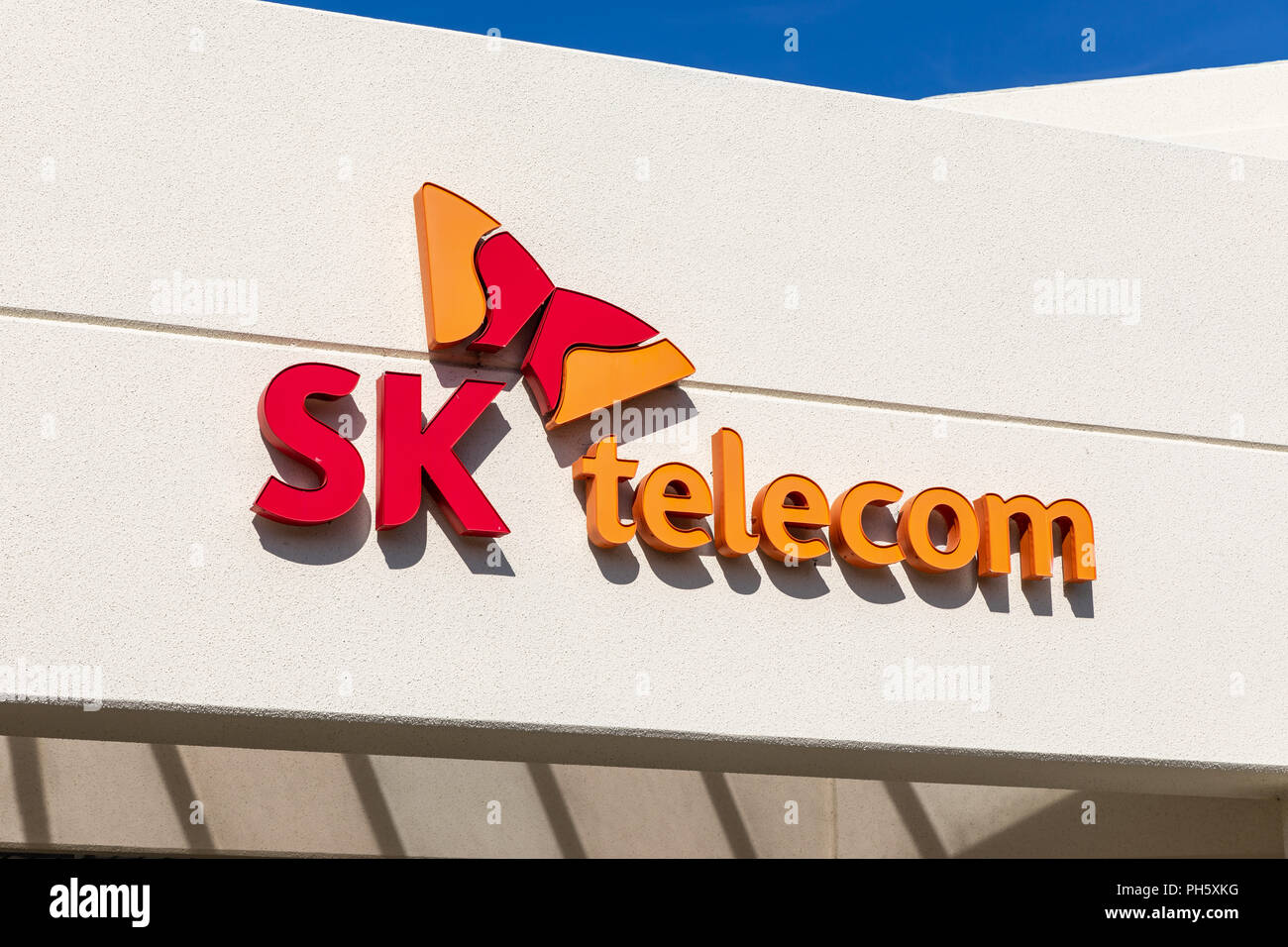
SK Telecom has been cooperating with AWS since February of this year to deploy AWS Wavelength Zones on SK Telecom’s 5G network and worked with 20 enterprise customers to test the service.
SKT and AWS are actively cooperating in the area of non-face-to-face services as demand grows due to the pandemic. The two companies have been working with video conferencing solution provider Gooroomee to build an environment where two-way video conferencing and remote education services are provided without delay, and have realized a service with a latency of less than 100 milliseconds for multiple simultaneous sessions.
“With AWS Wavelength on SKT’s 5G network, customers in South Korea can develop applications that take advantage of ultra-low latencies to address use cases like machine learning inference at the edge, smart cities and smart factories, and autonomous vehicles – all while using the same familiar AWS services, API, and tools to deploy them to 5G networks worldwide,” said Matt Garman, Vice President of Sales and Marketing, AWS.
“In collaboration with AWS, SK Telecom has successfully integrated private 5G and edge cloud. By leveraging this new technology, we will lead the efforts to create and expand innovative business models in game, media services, logistics, and manufacturing industries,” said Ryu Young-sang, President of MNO at SK Telecom.
………………………………………………………………………………………………………………………………
SK Telecom and AWS also report that they have been working to improve operational stability of autonomous robots and efficiency in remote monitoring and control. Together with Woowa Brothers, the operator of food delivery app ‘Baedal Minjok,’ the two companies have completed tests of applying the 5G MEC service to outdoor food delivery robot Dilly Drive. Meanwhile, work continues with local robotics company Robotis to test run autonomous robots in the 5G cloud environment.
SK Telecom and AWS have also signed an agreement with Shinsegae I&C and Maxst to build an AR navigation and guidance system in the Coex Starfield shopping mall in Seoul. They are also working on potential use of the 5G cloud service with Deep Fine, an AR glass solution developer, and Dabeeo, a spatial recognition service provider. With the National IT Industry Promotion Agency (NIPA), SK Telecom has launched an open lab to develop realistic contents optimized for the 5G network and to support the growth of the related ecosystem.
Collaboration is also ongoing with Looxid Labs, a provider of real-time analysis for eye-gaze tracking and brain wave data, to develop services on the 5G MEC for a senior citizen center in Busan.
SK Telecom and AWS are also cooperating in the area of non-face-to-face services as demand grows due to the COVID-19 pandemic. The two companies have been working with video conferencing services provider Gooroomee to develop an environment where 2-way video conferencing and remote education services are provided without delay, and claim they have achieved a service with a latency of less than 100 milliseconds for multiple simultaneous sessions.
………………………………………………………………………………………………………………………………………………
References:
https://www.sktelecom.com/en/press/press_detail.do?page.page=1&idx=1494&page.type=all&page.keyword=
https://www.telecompaper.com/news/sk-telecom-launches-5gx-edge-cloud-service-with-aws–1366915


